In the heart of Aurangabad, Maharashtra, a hidden gem awaits. Bibi Ka Maqbara, often called the “Taj of the Deccan,” isn’t just a mausoleum; it’s a captivating testament to the grandeur and elegance of Mughal architecture.
Commissioned by Mughal Emperor Aurangzeb’s son, Azam Shah, in memory of his mother, Bibi Ka Maqbara arose between 1651 and 1661. The monument’s design is a beautiful blend of Persian and Mughal styles, echoing the iconic Taj Mahal in Agra. Yet, Bibi Ka Maqbara offers a unique charm all its own.
How to reach:
Soaring In: Aurangabad Airport (Chhatrapati Sambhaji Maharaj Airport), just 11 kilometers away, offers convenient connections to major cities like Mumbai, Delhi, and Hyderabad. Taxis and app-based cabs take about 30 minutes to reach the monument from the airport.
Railway Rendezvous: Aurangabad Railway Station, 6 kilometers from Bibi Ka Maqbara, is well-connected to cities across India. Auto-rickshaws, taxis, or public buses can whisk you to the monument in 15-20 minutes.
Bus Bonanza: Maharashtra State Road Transport Corporation (MSRTC) buses and private operators offer frequent services from Mumbai, Pune, Nashik, and other cities. The Central Bus Station is around 5 kilometers from the site, with taxis, auto-rickshaws, or local buses readily available for the final leg of your journey.
Road Trip Redefined: For those who enjoy the open road, Aurangabad is easily accessible via well-maintained highways. From Mumbai, the drive takes approximately 7-8 hours, covering 330 kilometers. Pune is a closer 230 kilometers away, reachable in 5-6 hours by car. Use GPS navigation to reach Bibi Ka Maqbara directly, and ample parking awaits you near the site.
Best time to visit:
Blissful Winters (November to February): This is the crowning jewel of seasons to visit Bibi Ka Maqbara. Imagine exploring the monument and its gardens bathed in cool, pleasant temperatures ranging from 10°C to 25°C. Perfect weather for unhurried exploration without succumbing to the summer heat. This period often coincides with vibrant cultural festivals in Aurangabad, offering a delightful immersion into local traditions.
Sultry Summers (March to June): Aurangabad summers can be quite the scorcher, with temperatures climbing between 25°C and a sizzling 40°C, often accompanied by high humidity. While the heat might be intense, early mornings or evenings offer a more tolerable experience. If a summer visit is unavoidable, pack your hydration essentials, opt for lightweight clothing, and don’t forget sunscreen!
Monsoon Magic (July to October): The monsoon season ushers in moderate to heavy rainfall, with temperatures ranging from 20°C to 30°C. Imagine Bibi Ka Maqbara enveloped in lush greenery, a refreshing transformation brought on by the rains. While you might encounter sudden showers and muddy paths, an umbrella or raincoat and proper footwear will ensure a smooth exploration.
Attractions:
Bibi Ka Maqbara:
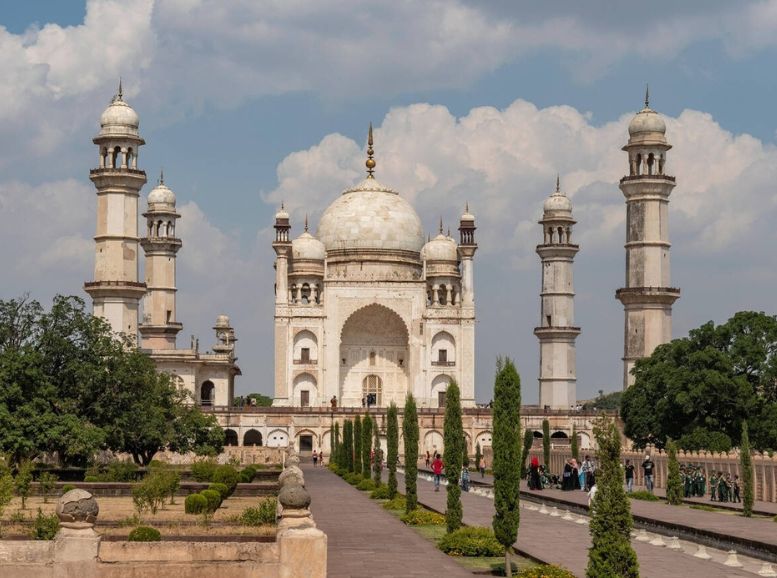
Bibi Ka Maqbara isn’t just a mausoleum; it’s the beating heart of Aurangabad. This stunning structure, built in the Mughal architectural style, bears an undeniable resemblance to the iconic Taj Mahal. But here’s the secret: it was built with love. Commissioned by Prince Azam Shah in memory of his mother, Dilras Banu Begum, Bibi Ka Maqbara stands as a testament to both maternal love and the grandeur of Mughal art and architecture.
Constructed between 1651 and 1661, the mausoleum is a visual feast. Imagine intricate marble carvings that dance across the facade, delicate floral motifs whispering stories, and detailed jaali work, a testament to the unmatched craftsmanship of the era.
The Garden (Charbagh):
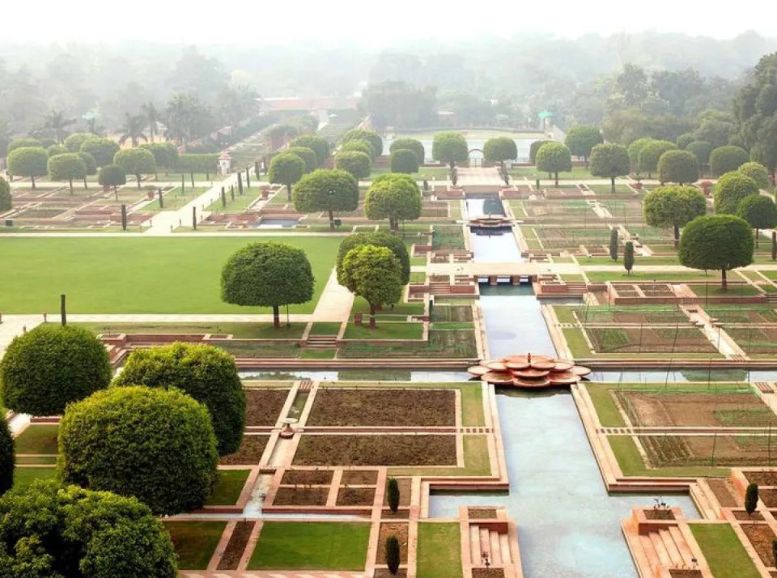
Beyond the captivating mausoleum lies the Charbagh garden, a testament to the beauty of Persian garden design. Imagine a perfect quadrilateral canvas, meticulously laid out to showcase both symmetry and aesthetic appeal. Walkways and water channels weave through the garden, creating a harmonious conversation between nature and architecture.
The Entrance Gate:
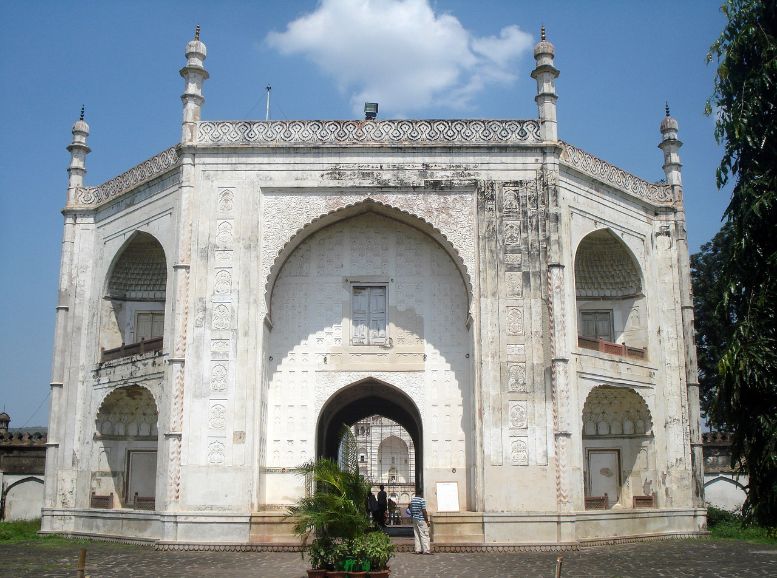
Before you even set foot within the Charbagh gardens, Bibi Ka Maqbara prepares you for its magnificence with its grand entrance gate. This isn’t just an entry point; it’s a captivating prelude to the opulence within.
Imagine a structure that soars with high arches, their grandeur accentuated by intricate floral and geometric patterns. Every detail whispers of Mughal architectural excellence. As you pass through this imposing gateway, a breathtaking vista unfolds before you. The mausoleum itself, perfectly framed by the arch, offers a tantalizing glimpse of what awaits – a monument that stuns with its beauty.
Tombs and Pavilions:
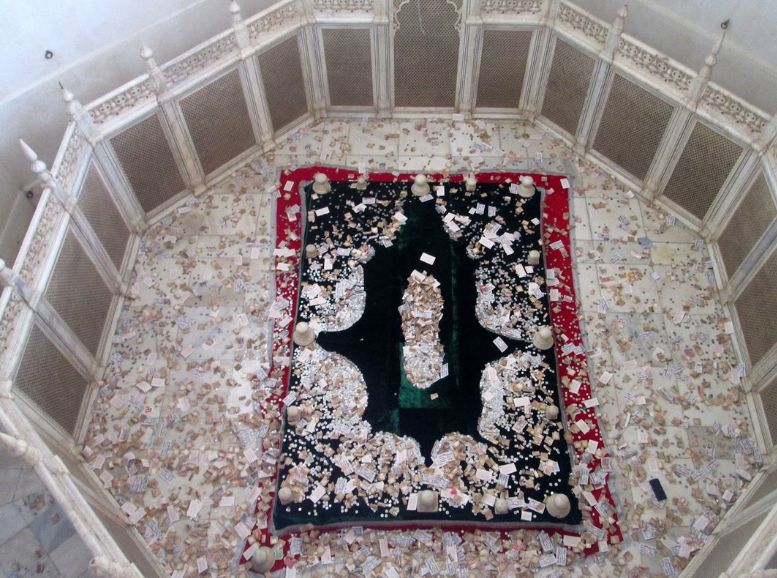
Bibi Ka Maqbara isn’t just about the awe-inspiring central mausoleum. Scattered around this architectural marvel lie smaller tombs and pavilions, each a captivating piece of history waiting to be unraveled.
These structures, though not as grand as the centerpiece, hold immense historical and architectural significance. Imagine stepping back in time and witnessing firsthand the funerary practices of the era. The smaller tombs, adorned with elegant yet simpler carvings, offer a fascinating contrast to the opulent main mausoleum. Their understated beauty speaks volumes about the lives they commemorate – often lesser-known figures from the Mughal period. Exploring these tombs adds layers of historical context, reminding us that Bibi Ka Maqbara is not just a monument, but a window into the past.
Mosque:
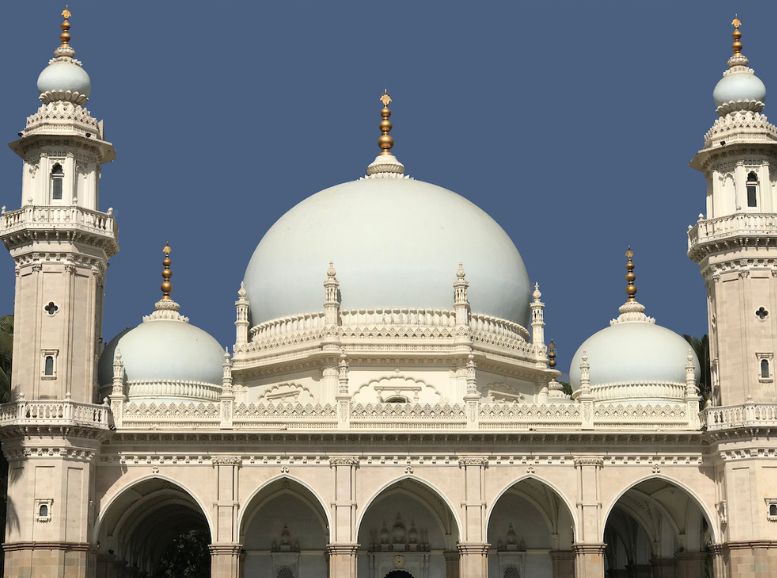
Standing shoulder-to-shoulder with the opulent mausoleum is a smaller structure that speaks a different language entirely. This is the mosque at Bibi Ka Maqbara, a place of quiet elegance that exemplifies the simplicity and spiritual serenity of Mughal religious architecture.
Unlike the grandeur of the mausoleum, the mosque is an exercise in restraint. Clean lines and a minimalistic design take center stage, creating a space dedicated solely to worship and reflection. Imagine a central prayer hall bathed in natural light filtering through arched entrances and a small, serene courtyard. The atmosphere is one of peace, a stark contrast to the awe-inspiring presence of the main structure.
Local Experiences:
- Taste of Maharashtra: Indulge in local favorites like Misal Pav, a spicy lentil stew with bread, Vada Pav, a potato fritter in a bun, and Puran Poli, a sweet flatbread filled with lentils and jaggery.
- Hyderabadi Delights: Savor the city’s historical connection with Hyderabad by experiencing its famous Hyderabadi Biryani, a flavorful rice dish with meat or vegetables.
- Festival Frenzy: Plan your visit around vibrant celebrations like Ganesh Chaturthi, honoring the elephant god Ganesha, or Diwali, the festival of lights. Witness traditional Maharashtrian festivities and immerse yourself in the local customs and rituals.
- Market Magic: Explore bustling markets like Gul Mandi and Aurangabad City Chowk for unique finds. Take home a Paithani saree, a luxurious silk saree known for its intricate designs, a Himroo shawl, a fine blend of silk and cotton, or a piece of Bidriware, a metal handicraft inlaid with silver. Look for handcrafted jewelry, traditional fabrics, and souvenirs that capture the essence of Aurangabad.
- Abode of Ancient History: Delve into the region’s rich Buddhist heritage by visiting the Aurangabad Caves, located near Bibi Ka Maqbara. Marvel at the intricate rock-cut architecture and carvings that stand as testaments to this bygone era.
- Textile Trail: Visit the Himroo Factory and Paithani Weaving Center to witness the age-old techniques used to create these exquisite textiles. Learn about the history and craftsmanship behind these beautiful fabrics and take home a piece as a memento.
Travel tips:
- Do Your Research: Check timings and entry fees for Bibi Ka Maqbara to avoid any hiccups. The monument is usually open from sunrise to sunset with separate fees for Indian and foreign tourists.
- Climate Considerations: Aim for a visit between November and February when the weather is pleasant for exploring the outdoors.
- Sun Smarts: Aurangabad can be sunny, especially in summer. Pack sunscreen, a hat, and sunglasses for protection while exploring the monument and gardens.
- Footwear for Comfort: The complex involves walking on pathways and uneven terrain. Comfortable walking shoes are a must for a smooth experience.
- Cultural Awareness: Bibi Ka Maqbara is a place of cultural and religious significance. Dress modestly, covering shoulders and knees, especially if you plan to visit the mosque.
- Hydration is Key: Carry a reusable water bottle, especially during warmer months. Refreshment stalls and cafes are also nearby for drinks and snacks.
- Guided Insights: Consider hiring a local guide to unlock the history, architecture, and stories behind Bibi Ka Maqbara. They can provide valuable information to enrich your visit.
- Photography Tips: Capture Bibi Ka Maqbara’s beauty throughout the day. Early mornings and sunsets offer softer light, enhancing the monument’s aesthetics.
- Beyond Bibi Ka Maqbara: Extend your exploration to nearby attractions like the Aurangabad Caves, Daulatabad Fort, and Grishneshwar Temple – all significant historical sites.
- A Culinary Adventure: Don’t miss the chance to savor local Maharashtrian and Hyderabadi cuisine. Sample Hyderabadi biryani, Misal Pav, and local sweets for a complete cultural immersion.
Conclusion
Unveiling the architectural marvel of Bibi Ka Maqbara in Aurangabad, Maharashtra, is like stepping into a Mughal dream. Nicknamed the “mini Taj Mahal,” this mausoleum stuns with intricate carvings, serene Charbagh gardens, and a rich history as a testament to maternal love. But Aurangabad offers more than just breathtaking beauty. Immerse yourself in a vibrant tapestry of experiences – savor the flavors of Maharashtrian and Hyderabadi cuisine, explore the historical significance of the Aurangabad Caves and Daulatabad Fort, or witness the joyous energy of local festivals. To ensure a smooth and enriching trip, visit our travel guide website, Xplro.com, for valuable tips on timings, packing essentials, and exploring beyond Bibi Ka Maqbara. Embrace the grandeur, delve into history, and be captivated by the magic of the Deccan!
FAQs
What is Bibi Ka Maqbara?
- Bibi Ka Maqbara is a mausoleum located in Aurangabad, Maharashtra, India, built in the 17th century by Prince Azam Shah in memory of his mother, Dilras Banu Begum.
Where exactly is Bibi Ka Maqbara located?
- Bibi Ka Maqbara is situated in Aurangabad, approximately 5 kilometers from the city center in Maharashtra, India.
What are the operating hours of Bibi Ka Maqbara?
- Bibi Ka Maqbara is typically open to visitors from [opening time]. Please verify locally for current operating hours.
What is the entrance fee for Bibi Ka Maqbara?
- The entry fee for Bibi Ka Maqbara is [fee] for Indian nationals and [fee] for foreign tourists. Prices may vary, so it’s advisable to check locally.
What is the historical significance of Bibi Ka Maqbara?
- Bibi Ka Maqbara was commissioned by Prince Azam Shah, son of Emperor Aurangzeb, as a tribute to his mother. Construction took place between [dates], and it is often called the “Taj of the Deccan” due to its resemblance to the Taj Mahal.
What architectural style does Bibi Ka Maqbara follow?
- Bibi Ka Maqbara is built in the Mughal architectural style, featuring white marble, intricate carvings, and a symmetrical layout that combines Persian and Indian design elements.
Are there any specific rules or dress codes for visiting Bibi Ka Maqbara?
- Visitors are encouraged to dress modestly and respect the cultural and religious sanctity of the site. It is recommended to cover shoulders and knees, especially when entering the mosque within the complex.
Is photography permitted inside Bibi Ka Maqbara?
- Yes, photography for personal use is generally allowed inside Bibi Ka Maqbara. However, professional photography or videography may require special permission.
What are some nearby attractions to explore near Bibi Ka Maqbara?
- Nearby attractions include the Aurangabad Caves, Daulatabad Fort, Grishneshwar Temple, and Panchakki. These sites offer additional insights into the historical and cultural heritage of the region.
Is there parking available at Bibi Ka Maqbara?
- Yes, there is ample parking space available near Bibi Ka Maqbara for visitors arriving by car or motorcycle.
Can I hire a guide at Bibi Ka Maqbara?
- Yes, local guides are available at Bibi Ka Maqbara to offer guided tours and enhance your understanding of the monument’s history, architecture, and significance.
Is Bibi Ka Maqbara accessible for differently-abled visitors?
- Efforts have been made to ensure accessibility for differently-abled visitors at Bibi Ka Maqbara, with ramps and other facilities provided to facilitate their visit.





